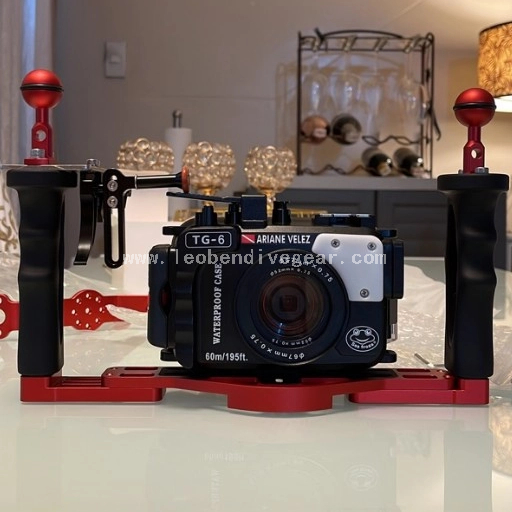- All
- Product Name
- Product Keyword
- Product Model
- Product Summary
- Product Description
- Multi Field Search
Views: 8 Author: Site Editor Publish Time: 2024-07-13 Origin: Site

Photography underwater presents several unique challenges and differences compared to shooting on land. Here are some key distinctions:
On Land,
Lighting conditions on land are generally more stable and predictable. Natural light is consistent unless affected by weather or time of day.
Colors are more vibrant and contrasts are more distinct, especially in good lighting conditions.Colors are more vibrant and contrasts are more distinct, especially in good lighting conditions.
Mobility is generally easier and less constrained. Photographers can move freely and adjust positions more readily.
Cameras are used without additional protective housing, providing easier access to controls and settings.
Composition can include a wider range of subjects and landscapes with more predictable perspectives and dimensions.
Environmental factors typically involve weather conditions and terrain, which are generally more predictable and manageable.
Post-processing focuses more on enhancing natural colors and adjusting lighting and contrast to refine the image.
Photography Underwater:
Light behaves differently underwater compared to on land due to water's properties of absorption and scattering. Here's a general overview of how light changes with depth in water:
Absorption of Light:
Red Light: Absorbed quickly within the first few meters (around 10-15 feet).
Orange and Yellow Light: Absorbed at moderate depths (around 30-50 feet).
Green and Blue Light: Absorbed less rapidly, allowing them to penetrate deeper into the water.
Different colors of light are absorbed at different rates as they pass through water:
Color and Contrast:
Underwater: Water absorbs and scatters light, reducing color saturation and contrast. Red and orange hues are the first to be absorbed, leaving a blue-green tint to underwater photos. Getting close to your subject helps minimize the water between you and them, resulting in clearer, more colorful images.
Buoyancy and Mobility:
Underwater: Photographers must manage buoyancy to stay neutrally buoyant and avoid disturbing marine life or stirring up sediment. This requires finesse and control to move smoothly and capture steady shots.
Equipment and Housing:
Underwater: Specialized equipment like waterproof housings is necessary to protect cameras and lenses from water damage. These housings must be compatible with specific camera models and rated for various depths.
Composition and Perspective:
Underwater: Composition often includes using natural elements like coral reefs, rock formations, and marine life to create depth and interest. Perspectives can vary significantly due to the three-dimensional nature of the underwater environment.
Environmental Considerations:
Underwater: Environmental factors like currents, visibility, and water temperature play a significant role and can vary greatly depending on the dive location and conditions.
Post-Processing:
Underwater: Post-processing often involves correcting color balance to compensate for water's color absorption, enhancing contrast, and reducing backscatter (unwanted particles in the water).
Understanding these differences allows photographers to adapt their techniques and equipment effectively when transitioning between shooting underwater and on land, ensuring they capture the best possible images in each environment.
Here are some solutions tailored to address the unique challenges of underwater photography based on the distinctions mentioned:
Lighting Conditions:
Underwater Solution: Use artificial lighting such as strobes or underwater lights to supplement natural light. This helps restore colors and details lost at depth. Experiment with different angles and distances to avoid backscatter and achieve optimal lighting.
On Land Solution: Utilize natural light effectively by choosing the right time of day and position relative to the sun. Consider using reflectors or diffusers to soften harsh light and enhance shadows.
Color and Contrast:
Underwater Solution: Get closer to your subject to minimize the water column between you and the subject. Use wide-angle lenses to capture larger scenes and bring more light into the frame, enhancing colors and contrasts.
On Land Solution: Adjust camera settings such as white balance and contrast to accurately represent colors and tones in your photographs. Use polarizing filters to reduce glare and enhance color saturation.
Buoyancy and Mobility:
Underwater Solution: Practice buoyancy control techniques to maintain a steady position without disturbing marine life or stirring up sediment. Use dive fins for precise movements and positioning.
On Land Solution: Take advantage of stable footing and mobility to explore different angles and perspectives. Use tripods or stabilizers for steady shots and to experiment with longer exposures.
Equipment and Housing:
Underwater Solution: Invest in quality underwater housings that are specifically designed for your camera model and rated for the depths you plan to dive. Ensure all seals are properly maintained and regularly serviced to prevent leaks.
On Land Solution: Choose cameras and lenses that meet your specific photography needs without the need for additional waterproofing. Use protective cases or bags to safeguard equipment from dust, moisture, and impact.
Composition and Perspective:
Underwater Solution: Use natural elements like coral reefs, rock formations, and marine life as focal points to create depth and interest in your compositions. Experiment with different angles and perspectives to capture unique underwater scenes.
On Land Solution: Incorporate leading lines, symmetry, and framing techniques to guide the viewer's eye and create compelling compositions. Explore different vantage points to capture familiar subjects from new perspectives.
Environmental Considerations:
Underwater Solution: Check local dive conditions and plan dives during optimal visibility periods. Monitor currents and adjust dive plans accordingly to ensure safety and maximize photographic opportunities.
On Land Solution: Stay informed about weather forecasts and plan outdoor shoots during favorable lighting conditions. Use weather-sealed equipment and protective gear to withstand various environmental challenges.
Post-Processing:
Underwater Solution: Use photo editing software to adjust color balance, enhance contrast, and remove backscatter. Fine-tune exposure settings to bring out details and textures in underwater images.
On Land Solution: Process images to maintain natural colors and tones. Use editing tools to refine lighting, sharpen details, and crop images for better composition.
By applying these tailored solutions, photographers can overcome the unique challenges presented by underwater and land-based photography, ensuring they capture compelling and visually stunning images in any environment.